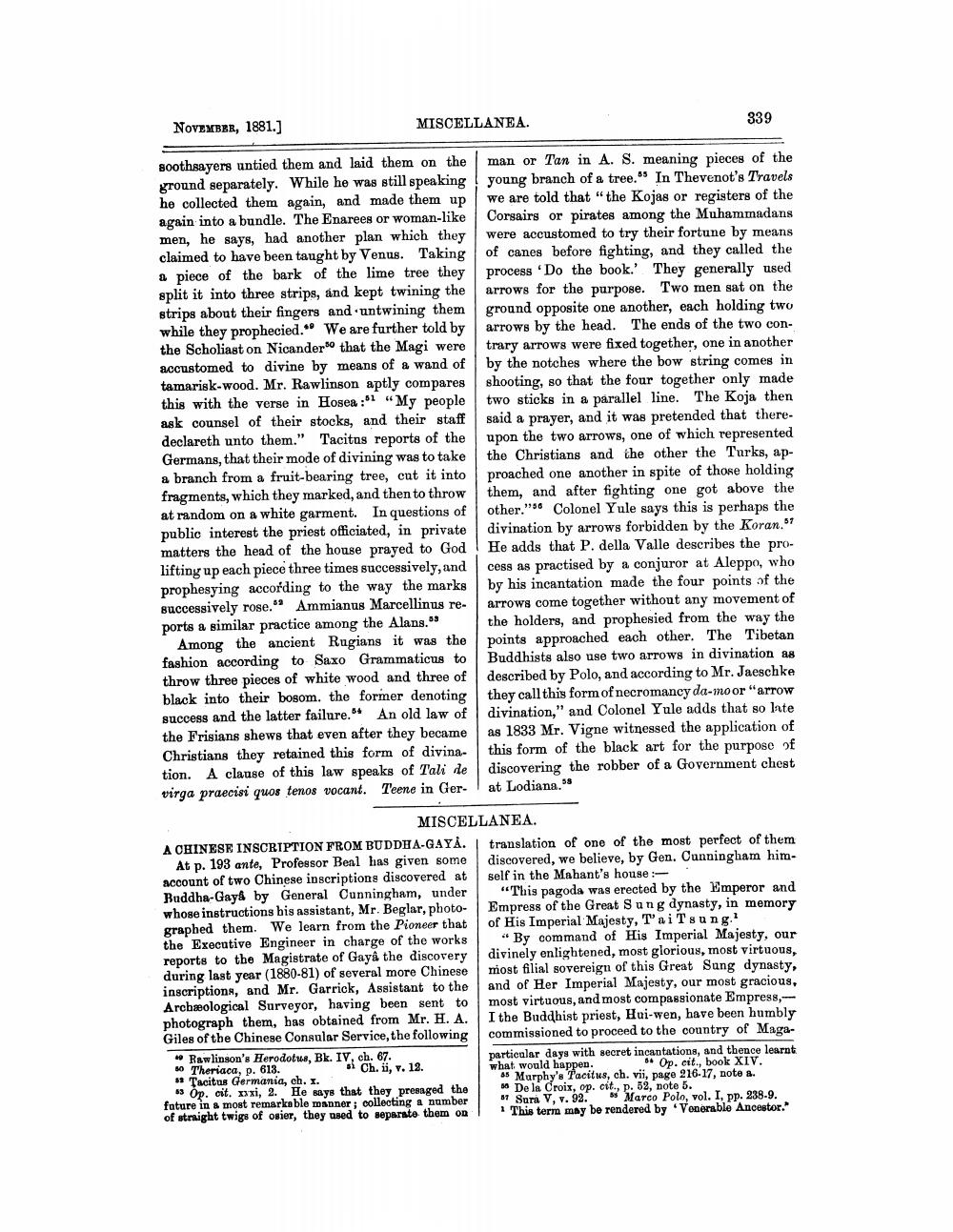________________
MISCELLANEA.
NOVEMBER, 1881.]
soothsayers untied them and laid them on the ground separately. While he was still speaking he collected them again, and made them up again into a bundle. The Enarees or woman-like men, he says, had another plan which they claimed to have been taught by Venus. Taking a piece of the bark of the lime tree they split it into three strips, and kept twining the strips about their fingers and untwining them while they prophecied." We are further told by the Scholiast on Nicanders that the Magi were accustomed to divine by means of a wand of tamarisk-wood. Mr. Rawlinson aptly compares this with the verse in Hosea :51 "My people ask counsel of their stocks, and their staff declareth unto them." Tacitus reports of the Germans, that their mode of divining was to take a branch from a fruit-bearing tree, cut it into fragments, which they marked, and then to throw at random on a white garment. In questions of public interest the priest officiated, in private matters the head of the house prayed to God lifting up each piece three times successively, and prophesying according to the way the marks successively rose." Ammianus Marcellinus reports a similar practice among the Alans.""
Among the ancient Rugians it was the fashion according to Saxo Grammaticus to throw three pieces of white wood and three of black into their bosom. the former denoting success and the latter failure." An old law of the Frisians shews that even after they became Christians they retained this form of divination. A clause of this law speaks of Tali de virga praecisi quos tenos vocant. Teene in Ger
Rawlinson's Herodotus, Bk. IV, ch. 67.
A CHINESE INSCRIPTION FROM BUDDHA-GAYA. At p. 193 ante, Professor Beal has given some account of two Chinese inscriptions discovered at Buddha-Gays by General Cunningham, under whose instructions his assistant, Mr. Beglar, photographed them. We learn from the Pioneer that the Executive Engineer in charge of the works reports to the Magistrate of Gayâ the discovery during last year (1880-81) of several more Chinese inscriptions, and Mr. Garrick, Assistant to the Archæological Surveyor, having been sent to photograph them, has obtained from Mr. H. A. Giles of the Chinese Consular Service, the following
MISCELLANEA.
si Ch. ii, v. 12.
so Theriaca, p. 613.
53 Tacitus Germania, ch. x.
53 Op. cit. xxxi, 2. He says that they presaged the future in a most remarkable manner; collecting a number of straight twigs of osier, they used to separate them on
339
man or Tan in A. S. meaning pieces of the young branch of a tree.55 In Thevenot's Travels we are told that "the Kojas or registers of the Corsairs or pirates among the Muhammadans were accustomed to try their fortune by means of canes before fighting, and they called the process 'Do the book. They generally used arrows for the purpose. Two men sat on the ground opposite one another, each holding two arrows by the head. The ends of the two contrary arrows were fixed together, one in another by the notches where the bow string comes in shooting, so that the four together only made two sticks in a parallel line. The Koja then said a prayer, and it was pretended that thereupon the two arrows, one of which represented the Christians and the other the Turks, approached one another in spite of those holding them, and after fighting one got above the other." Colonel Yule says this is perhaps the divination by arrows forbidden by the Koran." He adds that P. della Valle describes the process as practised by a conjuror at Aleppo, who by his incantation made the four points of the arrows come together without any movement of the holders, and prophesied from the way the points approached each other. The Tibetan Buddhists also use two arrows in divination as described by Polo, and according to Mr. Jaeschke they call this form of necromancy da-moor "arrow divination," and Colonel Yule adds that so late as 1833 Mr. Vigne witnessed the application of this form of the black art for the purpose of discovering the robber of a Government chest at Lodiana.58
translation of one of the most perfect of them discovered, we believe, by Gen. Cunningham himself in the Mahant's house:
"This pagoda was erected by the Emperor and Empress of the Great Sung dynasty, in memory of His Imperial Majesty, T'a i Tsung'
By command of His Imperial Majesty, our divinely enlightened, most glorious, most virtuous, most filial sovereign of this Great Sung dynasty, and of Her Imperial Majesty, our most gracious, most virtuous, and most compassionate Empress,I the Buddhist priest, Hui-wen, have been humbly commissioned to proceed to the country of Magaparticular days with secret incantations, and thence learnt what would happen. 5 Op. cit., book XIV. 45 Murphy's Tacitus, ch. vii, page 216-17, note a. De la Croix, op. cit., p. 52, note 5.
57 Sura V, v. 92. 55 Marco Polo, vol. I, pp. 238-9. This term may be rendered by 'Venerable Ancestor."




